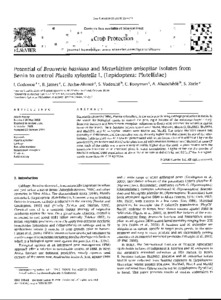| dc.contributor.author | Godonou, I. |
| dc.contributor.author | James, B. |
| dc.contributor.author | Atcha-Ahowé, C. |
| dc.contributor.author | Vodouhe, S. |
| dc.contributor.author | Kooyman, C. |
| dc.contributor.author | Ahanchédé, A. |
| dc.contributor.author | Korie, S. |
| dc.date.accessioned | 2019-12-04T11:11:50Z |
| dc.date.available | 2019-12-04T11:11:50Z |
| dc.date.issued | 2009 |
| dc.identifier.citation | Godonou, I., James, B., Atcha-Ahowé, C., Vodouhe, S., Kooyman, C., Ahanchédé, A., & Korie, S. (2009). Potential of Beauveria bassiana and Metarhizium anisopliae isolates from Benin to control Plutella xylostella L.(Lepidoptera: Plutellidae). Crop Protection, 28(3), 220-224. |
| dc.identifier.issn | 0261-2194 |
| dc.identifier.uri | https://hdl.handle.net/20.500.12478/2506 |
| dc.description | Published Online |
| dc.description.abstract | Diamondback moth (DBM), Plutella xylostello L., is the main pest limiting cabbage production in Benin. Inthe search for biological agents to control the pest, eight isolates of the entomopathogenic fungiBeauveria bassiana and Metarhizium anisopliae indigenous to Benin were screened for virulence againstlarvae of the insect. The B. bassianc isolates tested were Bba14, Bba5644, 8ba5645, 8ba5653, Bba5654,and Bba5655, and M. anisopliae isolates were Ma178 and Ma182. The isolate Bba5653 caused 94%mortality of DBM larvae, and the mortality was significantly higher than that caused by any of the otherisolates. Cabbage yield was 44.1 tlha for plots treated with water formulation of Bba5653 at 1 kg conidiapowder (CP) per hectare and 41.9 t/ha for plots treated with emulsion formulation of Bba5653 at same CPdose. Each of the yields was approximately threefold higher than the yield in plots treated with theinsecticide bifenthrin or in untreated plots. In water formulations, 1 kg/ha of the conidia powder ofBba5653 reduced DBM populations at about the same rate as did 0.75 kg and 0.5 kgCP/ha, but signifi-cantly more than did 0.25 kgCP/ha. |
| dc.description.sponsorship | Swiss Agency for Development and Cooperation |
| dc.format.extent | 220-224 |
| dc.language.iso | en |
| dc.subject | Plutella Xylostella |
| dc.subject | Cabbage |
| dc.subject | Beauveia Bassiana |
| dc.subject | Metorhizlum Anisopliae |
| dc.subject | Virulence |
| dc.subject | Field Efficary |
| dc.subject | Chemical Control |
| dc.subject | Vegetable Producers |
| dc.subject | Hymenoptera |
| dc.subject | Braconida |
| dc.subject | Entomopathogenic Fungal0 |
| dc.title | Potential of Beauveria bassiana and Metarhizium anisopliae isolates from Benin to control Plutella xylostella L. (Lepidoptera: Plutellidae) |
| dc.type | Journal Article |
| dc.description.version | Peer Review |
| cg.contributor.affiliation | International Institute of Tropical Agriculture |
| cg.contributor.affiliation | Université d'Abomey Calavi |
| cg.contributor.affiliation | Fondation Agir pour I'Education et Ia Sante |
| cg.coverage.region | Africa |
| cg.coverage.region | West Africa |
| cg.coverage.country | Benin |
| cg.coverage.country | Senegal |
| cg.isijournal | ISI Journal |
| cg.authorship.types | CGIAR and developing country institute |
| cg.iitasubject | Disease Control |
| cg.iitasubject | Aflatoxin |
| cg.iitasubject | Plant Genetic Resources |
| cg.iitasubject | Plant Diseases |
| cg.iitasubject | Plant Ecology |
| cg.iitasubject | Plant Health |
| cg.iitasubject | Pests Of Plants |
| cg.journal | Crop Protection |
| cg.howpublished | Formally Published |
| cg.accessibilitystatus | Limited Access |
| local.dspaceid | 93257 |
| cg.identifier.doi | https://dx.doi.org/10.1016/j.cropro.2008.10 |

